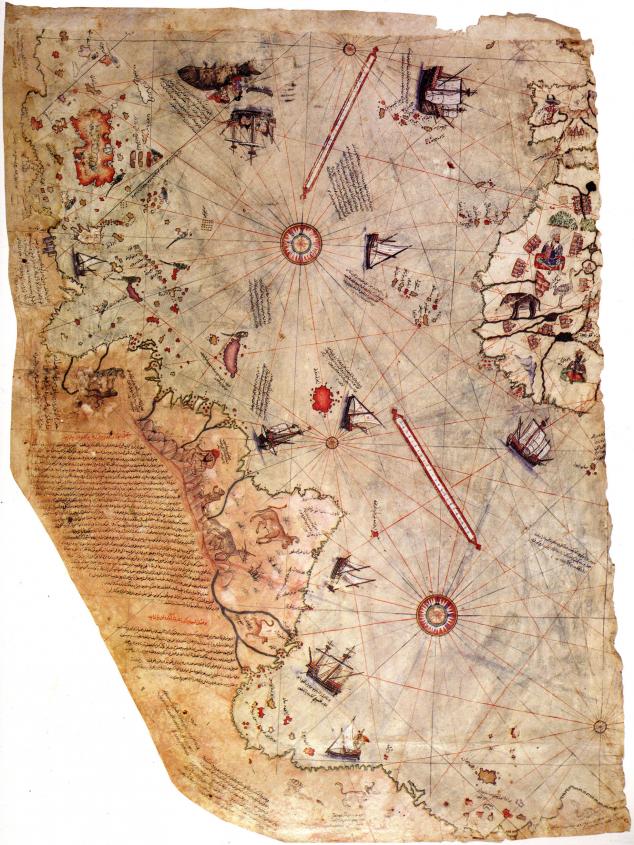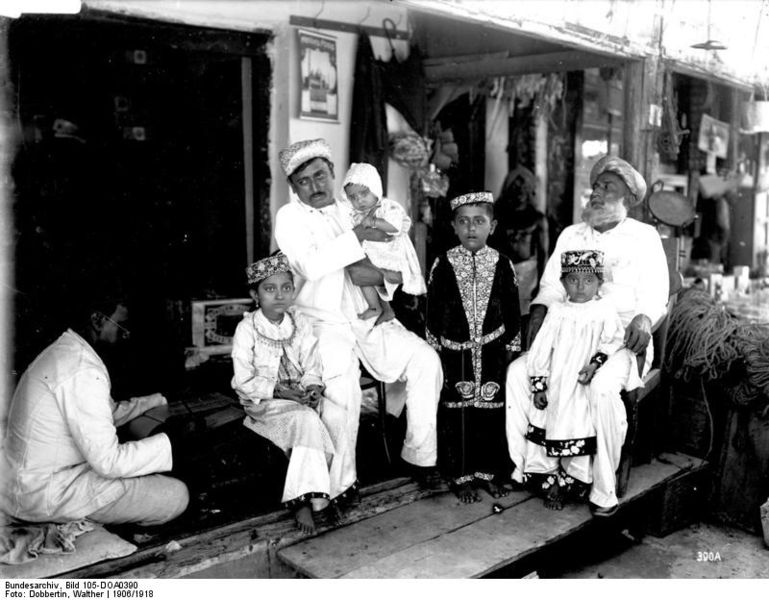In the late 15th century, Vasco da Gama rounded the Cape of Good Hope and conquered the Indian Ocean, bringing the rich trade under the direct control of the crowned heads of Europe and their appointed Indian Ocean Trading Companies. Or did he? Did Europe ever really come to dominate the 90,000 year old trade, or did it become just another in a series of actors competing for attention in an antique system of exchanges and commodities?
Guest Susan Douglass offers a nuanced view of the last five hundred years of European encounters with a deeply established international economy, makes the case that the remarkable story of this resource rich region isn’t over just yet.
Guests
 Susan DouglassDirector of Educational Outreach at the Center for Contemporary Arab Studies at Georgetown University
Susan DouglassDirector of Educational Outreach at the Center for Contemporary Arab Studies at Georgetown University
Hosts
 Christopher RosePostdoctoral Fellow, Institute for Historical Studies, The University of Texas at Austin
Christopher RosePostdoctoral Fellow, Institute for Historical Studies, The University of Texas at Austin

We’ve mentioned a few times that the model of trading in the Indian Ocean and on into Southeast and East Asia really changed when the Europeans arrived on the scene, which happened at the end of the 15th century. Can you talk a little more about what that entailed, and what kind of changes took place?
Well, I think first there’s a necessity to talk about what didn’t take place. First of all, the Portuguese and their other European rivals didn’t bring the Indian Ocean trade into being, nor during the beginning of their presence there did they greatly increase the volume of trade if, for no other reason than the fact that they didn’t have a whole lot to bring into the trade that was ongoing at the time. They didn’t have spices, they didn’t have silk; they had wool and a few other items that came from Europe. What attracted them and their royal sponsors were the goods that were there in the Indian Ocean. So, a) they didn’t bring the trade into being and, b) the existing Indian Ocean trade networks didn’t collapse. To put it in a funny way, they didn’t roll over and play dead with the arrival of Vasco da Gama and his successors in the Indian Ocean.
Rather, the Portuguese, the French, the English, Spanish, and later other merchants joined the direct trade for the first time and had to adjust themselves to the local situations. English traders even relied upon local capital at times to finance their trade in Bengal, for example. It was difficult, dangerous, distant, and daunting to be a factor–that is, an agent of one of these trading companies—in a faraway land. Many of them died, many of them went broke, many of them got into all sorts of other trouble. They also intermarried with local women at times, to the advantage of the latter.
Over time, you can say that there was an important change in the terms of trade, and there were important changes in the effect of the globalization of trade. The earth had been circumnavigated and now, various goods that were available through mining and colonization of the New World became available and changed things in the Indian Ocean environment.
These are things that didn’t happen. What would you say were the more profound changes that did take place?
As I mentioned, the presence of wealth and power as a result of European discovery of the Americas changed some of the items that were available there and changed some of the terms of trade, especially of the way that goods could be paid for by European merchants. Over time, the accumulation of capital, in large part from the colonies that were producing gold and silver in the New World in the hands of European trading companies began to change the terms of trade by infusing a lot of precious metal into the trade that hadn’t been a major factor previously. Barter and other types of exchange were probably more important before.
The European trading companies were chartered, they possessed military power, they minted coins and issued paper money, and monopolized trade for the mother country. This process, followed by European entrenchment and colonization, took centuries to alter the balance in favor of European merchants and political power.
In the meantime, another important thing happened. That was that the Europeans began an apprenticeship in terms of styles that were in demand in Europe, creating demand for certain commodities. They learned how these things were grown, how the textiles were produced. For example, cotton prints—Europeans learned how to produce colored cottons with dyes and fixatives so that you could paint or print on cotton and not have the colors not run together. They also learned to reproduce and eventually modify the styles and designs that were considered beautifu, such as floral designs that go back millennia in the region, and were often based on tropical plants that didn’t exist in Europe.
One of the things that Europeans started to do is import substitution—what we talk about today in terms of developing countries. Europeans began to imitate some of these products, and to adopt the techniques in manufacturing them, and, eventually, to replicate them in mechanized ways. So, in crafts such as textiles, ceramics and others, Europeans served these apprenticeships to artisans in the various regions, and by way of import substitution and sometimes harsh penalties against importation into Europe, industrialization transformed these crafts into mechanically produced goods that could be mass produced cheaper and competed with artisan produced goods. At the same time, Europeans were introduced to exotic raw materials such as rattan, gutta percha, rubber that were used for ages in the region.
By then, the mid 19th century, military might had entrenched colonial powers—the British, Dutch, and French on the entire route to the Indian Ocean and within it. But, as these goods–ceramics and textiles were two of the major ones and, of course, spices as a commodity–became very popular in Europe, the demand increased exponentially for these goods. Merchants in Europe were trying to find ways to imitate them so as to have cheaper versions and versions that were not just for the elites but also for middle classes and others.
One other point that I want to mention is that, when we teach about the Columbian Exchange, we only talk about what came to Europe from the New World, such as tomatoes, peppers, and pumpkin. Sometimes we also teach about things that came to the Americas, like animals and grains. But we should also remember that because these trade routes in the Indian Ocean were so well established, the flow of Columbian Exchange goods from the New World was quite rapid in penetrating even as far as China. The arrival of the potato in China was enhancing nutrition there and causing massive population growth in less than 100 years, for example. The diets of people in the Old World were transformed and these crops from the Columbian Exchange were so widely disseminated that the words for them in various languages express uncertainty as to their actual origin. “Turkey” is one example—the word for which in Arabic is “Roman rooster” referring to the Ottomans as the successors to Rome, or Byzantium.

gouache on paper
Victoria & Albert Museum, London, UK
Indian, out of copyright
There is another famous example where the Mughal emperor apparently ate and had his court paint a turkey before the first Thanksgiving in the Americas. And this is one of the few things that you can actually document, because he had the painter paint the turkey before it went to the royal kitchens!
A lot of the silver that was being circulated in the Indian Ocean was coming out of the New World, it was being mined by the Spanish and taken directly to China across the Pacific if I’m not mistaken?
Exactly! Some of it also came in the other direction, but that is another thing that world historians have recently discovered. One of the more famous quips by an economist–A.G. Frank–is that Europeans bought a ticket on the Asian train with American silver. That kind of succinctly puts it in one statement.
With all of this trade and the entry of the Europeans onto the scene, were there any other developments? We’ve talked about social, we’ve talked about economics. This sort of trade can often lead to technological advances, sometimes even inadvertent ones. Do we see that here as well?
You definitely do. One of the things that took place while the world was still in the age of sail was the advancement of ships for use in long distance travel across the open oceans. When you look at the change in the routes–of course, we have the circumnavigation of Africa as one of the main routes that is obvious for change, but with the discovery of the southern Indian Ocean routes–these are called the Roaring Forties and the Screaming Sixties and so on, these are the higher degrees of latitude toward the South Pole. There were extremely strong winds, and a ship could hitch a ride on those winds and find themselves blown almost all the way to Australia and then make a sharp left turn and go up to Java, unless they crashed into the coast which somebody did and inadvertently discovered Australia.
These routes were dependent on things like the longitudinal clock that could be used to plot longitude at sea. You have wonderful paintings of these ships being blown very quickly across these southern routes. When you compare them with these earlier periods, and ones that are still used throughout (from ancient times until today), the ones that hug the northern rim of the Indian Ocean, now you have these others being used. And then, of course, with the end of the age of sail and the beginning of steam travel, which was kind of a mixed affair at the beginning, they were able to use these routes and became independent of the winds, or at least somewhat independent of the winds. And yet, these routes had been opened up and still used frequently because they enabled a quicker sail across fast differences.
One of the other questions that pops up is the human factor in all of this. There’s a large resident South Asian population in East Africa, a lot of whom are affiliated with the merchant classes. Is this something that we see as the result of European colonialism, or is that something that’s always been?
I think the answer is “both.” You had in very early trade, even in pre-Islamic times, Yemenis–southern Arabians–traveling across the monsoon routes and taking up residence in areas of the coast where they did business. You had the famous Cairo Geniza documents that give evidence of Jewish trading families, moving around in these areas. The famous book by Amitav Ghosh, “In an Antique Land,” talking about the family relations that testify to these temporary migrations and more permanent migrations around the area. Even before Islam, you had Persian families settling along the East African coast. There is evidence of Hindus migrating into Southeast Asia and carrying Hinduism and all sorts of cultural and artistic influences there.

This all really steps up with colonialism. Colonial powers, having multiple colonies, were able to ship people around. The most famous example is the one you mentioned of the coolies who were recruited from agricultural peoples in India and brought to do projects in East Africa and South Africa. Indeed, Gandhi was one of the people who migrated through British colonialism–he got his start in South Africa. In addition to that there have been a number of studies that are quite interesting to go into on the prevalence of different types of slavery. Ibn Battuta back in the 14th century, again, mentioned the incredibly different ethnic groups that crewed the different ships, including Chinese ships would have had multiple ethnicities working as their crews. This goes all the way into the period where those crews were impressed as slaves from one place or another, you had people landing on islands during the colonial period and plantations were set up. Vanilla plantations on Reunion by the French, for example, where vanilla from the new world began to be grown in the Indian Ocean as a commodity. So, you have all kinds of motion and certainly it has continued into the modern period, and it has a very long duration.
As you mentioned, this trade has been going on for 90,000 years. What would you say are the lasting legacies of the Indian Ocean trade that we can still see?
I think one of them that struck me in doing the research for this project that involved over 500 entries in all kinds of topics from the first golf ball to the kind of materials that were used to sheathe transoceanic submarine cables and things like that, is that a lasting legacy of the Indian Ocean is the sheer number of goods and styles that have informed tastes today. When you think of rubber, when you think of silk, of any number of dyes of all kinds–these are the products that in their natural form were very much desirable and which have been synthesized through chemistry into synthetic forms that are widely used today. You can see a direct line to the discovery of these items, many of which are natural and come from this tropical paradise, this vast area, and have come into global trade, become commodities, and made into synthetics nowadays. So, I think that’s a striking of the legacy of this ocean.
It’s also important to remember that the trade has not ceased at all, it is a very active region today. It’s one to which manufacturing has returned. Some of the textile commodities that were first attractive to global trade, are being manufactured there. Maybe under different auspices, maybe under different terms, things like athletic clothing or T-shirts and so on, but we shouldn’t forget that those styles and those perennial favorites in terms of colors and designs and even the animal prints that you’re seeing now come from that tropical legacy of what is exotic and what is pleasing to the eye and so on.
I think it’s important to continue to look at the region and not just look at it as many curriculum units do just in the medieval period, “this is the time when we do the Indian Ocean.” I think looking at it in that continuity to the very earliest times of human migration to modern globalization is a very interesting exercise in seeing how things change and how things at the same time remain.